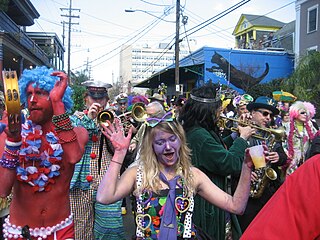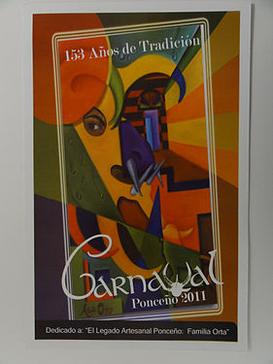
Mardi Gras is the final day of Carnival ; it thus falls on the day before the beginning of Lent on Ash Wednesday. Mardi Gras is French for "Fat Tuesday", reflecting the practice of the last night of consuming rich, fatty foods in preparation for the Christian fasting season of Lent, during which the consumption of such foods is avoided.

Carnival or Shrovetide is a festive season that occurs at the close of the Christian pre-Lenten period, consisting of Quinquagesima or Shrove Sunday, Shrove Monday, and Shrove Tuesday or Mardi Gras.

Aude is a department in Southern France, located in the Occitanie region and named after the river Aude. The departmental council also calls it "Cathar Country" after a group of religious dissidents active in the 12th to 14th centuries.

The Rex Organization, commonly referred to simply as Rex, is a New Orleans Carnival krewe which stages one of the city's most celebrated parades on Mardi Gras Day. Rex is Latin for 'king', and Rex reigns as "The King of Carnival".

The holiday of Mardi Gras is celebrated in southern Louisiana, including the city of New Orleans. Celebrations are concentrated for about two weeks before and through Shrove Tuesday, the day before Ash Wednesday. Mardi Gras is French for Fat Tuesday, the season is known as Carnival and begins on 12th Night, January 6th, and extends until midnight before Ash Wednesday. Club, or Krewe, balls start soon after, though most are extremely private, with their Kings and Queens coming from wealthy old families and their courts consisting of the season's debutantes. Most of the high society Krewes do not stage parades. As Fat Tuesday gets nearer, the parades start in earnest. Usually there is one major parade each day ; many days have several large parades. The largest and most elaborate parades take place the last five days of the Mardi Gras season. In the final week, many events occur throughout New Orleans and surrounding communities, including parades and balls.

Mardi Gras Indians are African American carnival revelers in New Orleans, Louisiana, who dress up for Mardi Gras in suits influenced by the cultural practices of Native Americans, West Africans, and Afro-Caribbeans. The music, dance, and regalia from these cultures created the Mardi Gras Indian tradition during the era of slavery in Louisiana that continues today. This cultural tradition is a part of the African and African diaspora decorative aesthetic, and is an African-American art form. Black masking Indians are a subculture in New Orleans.

Limoux is a commune and subprefecture in the Aude department, a part of the ancient Languedoc province and the present-day Occitanie region in southern France. Its vineyards are famous for being first to produce sparkling wine known as Blanquette de Limoux.

The Nice Carnival is one of the world's major carnival events, alongside the Brazilian Carnival, Venetian Carnival, and Mardi Gras in New Orleans. It is held annually in February and sometimes early March in Nice on the French Riviera.

Mardi Gras is the annual Carnival celebration in Mobile, Alabama. It is the oldest official Carnival celebration in the United States, started by Frenchman Nicholas Langlois in 1703 when Mobile was the capital of Louisiana. Although today New Orleans and South Louisiana celebrations are much more widely known for all the current traditions such as masked balls, parades, floats and throws were first created there. From Mobile being the first capital of French Louisiana (1702), the festival began as a French Catholic tradition. Mardi Gras has now evolved into a mainstream multi-week celebration across the spectrum of cultures, becoming school holidays for the final Monday and Tuesday, regardless of religious affiliation.

A masquerade ceremony is a cultural or religious event involving the wearing of masks. The practice has been seen throughout history from the prehistoric era to present day. They have a variety of themes. Their meanings can range from anything including life, death, and fertility. In the Dogon religion, the traditional beliefs of the Dogon people of Mali, there are several mask dances, including the Sigi festival. The Sigi entered the Guinness Book of Records as the "Longest religious ceremony".

Carnaval San Francisco, established 1979, is an annual street parade and festival in San Francisco, California, United States, held on the last weekend in May.

The Courir de Mardi Gras is a traditional Mardi Gras event held in many Cajun and Creole communities of French Louisiana on the Tuesday before Ash Wednesday. Courir de Mardi Gras is Louisiana French for "Fat Tuesday Run". This rural Mardi Gras celebration is based on early begging rituals, similar to those still celebrated by mummers, wassailers, and celebrants of Halloween. As Mardi Gras is the celebration of the final day before Lent, celebrants drink and eat heavily, dressing in specialized costumes, ostensibly to protect their identities. In Acadiana, popular practices include wearing masks and costumes, overturning social conventions, dancing, drinking alcohol, begging, trail riding, feasting, and whipping. Mardi Gras is one of the few occasions when people are allowed to publicly wear masks in Louisiana. Dance for a Chicken: The Cajun Mardi Gras, a documentary by filmmaker Pat Mire, provides insight into the history and evolution of this cultural tradition. In popular culture, two HBO series also make reference to the tradition.

Mardi Gras in the United States is celebrated in a number of cities and regions in the country. Most of these places trace their Mardi Gras celebrations to French, Spanish, and other Catholic colonial influences on the settlements over their history.

The Paris Carnival is an annual festival held in Paris, France. The carnival occurs after the Feast of Fools and has been held since the 16th century or earlier, with a long 20th century interregnum.

The Carnaval de Ponce, officially Carnaval Ponceño, is an annual celebration of the Carnival holiday held in Ponce, Puerto Rico. The celebration lasts one week, and like most observations of the holiday ends on Fat Tuesday. Thus, like the Carnival holiday in general, it is usually held in February and or March. It dates back to 1858. Some authorities, such as the Smithsonian Institution, believe the Ponce Carnaval can be traced to as far back as 250 years ago. The Carnaval coincides with the Mardi Gras of New Orleans, the Carnival of Venice, and Rio de Janeiro's Carnival and hundreds of other places that observe this holiday around the world. The estimated attendance is 100,000. Scenes of the 2011 Carnaval Ponceño were featured in the Travel Channel on 7 August 2011.

Haitian Carnival is a celebration held over several weeks each year leading up to Mardi Gras. Haitian Defile Kanaval is the Haitian Creole name of the main annual Mardi Gras carnival held in Port-au-Prince, Haiti.
The El Gran Carnaval de San Pedro is a 150-year-old traditional festival from Mestizo culture, which brought it down to northern Belize, San Pedro and Ambergris Caye. El Gran Carnaval is celebrated to begin the lent season.

The Bœuf Gras is an important festive figure that butchers or butcher boys display or - and - parade solemnly to music, usually at Carnival time. It may be a sculpted representation of a live animal, a real ox or another placid bovine.

Carnaval de Périgueux is a popular festival held in Périgueux, in the Dordogne department. Part of a festive tradition that dates back to the 11th century, the carnival today consists of a parade of floats and groups of musicians along the city's boulevards. The procession ends with the judgement and cremation of Pétassou on the quays of the Isle.





















